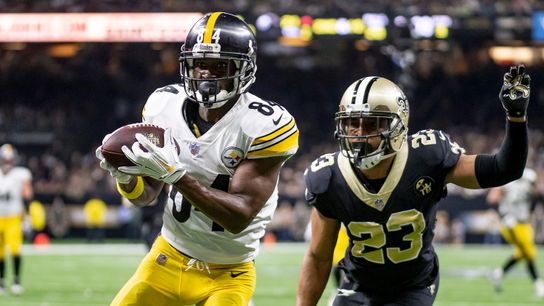Well, I planned on writing about the Steelers' inadequacies and beginning the postseason evaluation process to see what was better and worse about the 2018 season. There's a lot that went into the team's regression from 13-3 to 9-6-1, so I've been excited to dive into that.
And then, Antonio Brown happened. So that will have to wait a bit.
You've read Dejan Kovacevic's column on Mike Tomlin's accountability, or lack thereof, and Dale Lolley's account of the challenge the Steelers face with the crossroads Brown has created. But let's face the reality of what his departure might mean for the future of the offense.
First, let's look at how central Brown has been to the Steelers' offense over the years. This season, he became the first NFL wide receiver with six consecutive seasons with 100 or more receptions, and arguably has the best six year run of any wide receiver in NFL history: 686 receptions for 9,145 yards and 67 touchdowns.
It's worth noting that 2018 was the first time Brown accounted for less than 25 percent of the Steelers' overall targets since 2012. Here's a breakdown of his last five seasons:
Since Brown became the No. 1 receiver for the Steelers in 2013, the player that got the closest to the number of targets he received in any season was Emmanuel Sanders back in 2013, when he was targeted 113 times compared to Brown's 167.
But in 2018, JuJu Smith-Schuster accounted for 166 targets while Brown accounted for 168. That difference helped Ben Roethlisberger and the Steelers' offense become less predictable and open up other opportunities.
If Brown is not part of the team in 2018 and not replaced by another superstar wide receiver, it will change how defenses plan for the Steelers and take away Roethlisberger's biggest advantages against opposing defenses. You only have to look at the last two games of this season to see the difference in the offense with and without Brown.
Against the Saints' defense which ranked 14th in total defense and in scoring defense, the Steelers scored three touchdowns and a 2-point conversion for 28 points and looked unstoppable. But against the Bengals, who ranked 30th in scoring defense and dead last in total defense, the Steelers managed a measly 16 points, including only one touchdown.
Brown not being available changed a lot.
Here's a look at a failed third down attempt when Eli Rogers beat his initial coverage with an adjusted corner route. The Bengals roll a safety from the other side of the field to that side because that's where Smith-Schuster was, but when Rogers breaks free that safety comes to squeeze down on Rogers' route and forces a tough throw for Roethlisberger:
The Bengals were able to shift their coverage onto Smith-Schuster, and even without their top cornerback Dre Kirkpatrick available, it helped. Watch how, at the bottom of the formation, the safety devotes a complete double coverage against Smith-Schuster, leaving the rest of the defense in single coverage.
If Brown were on the field, he would get that attention and Smith-Schuster could beat his single coverage assignment. But here, he is blanketed and Roethlisberger is unable to find an open receiver:
These are all direct results of Brown's absence against the Bengals. It allows secondaries to be much more aggressive in their coverage against Smith-Schuster and forces lesser receivers like Rogers, Ryan Switzer and James Washington to make plays. Watch how that same ideology leads to Shaun Williams' interception returned for a touchdown in the first quarter.
Smith-Schuster is lined up in the slot just to the right of Matt Feiler on the right hashmark. The Bengals start by showing two high safeties as if in a Cover 2, but switch to a Cover 1 Robber defense with Williams playing the robber role and jumping Roethlisberger's pass to Smith-Schuster:
If Brown is on the field, he attracts that attention elsewhere and Smith-Schuster gets a chance to make a play. His presence has led to some of Smith-Schuster's biggest moments, including his 97-yard touchdown against the Broncos.
Watch how the safety committed to Brown's side of the field, even with a 3-time All-Pro and Pro Bowl cornerback assigned to cover Brown. That allows Smith-Schuster to beat the press coverage of Bradley Roby without worrying about safety help, and opens up the huge play:
Smith-Schuster is a very good player and could someday be great, but Brown is still the team's best receiver. His 20-yard touchdown against the Saints showed as much when they tried to disguise their double coverage of him and he broke it with his insanely quick release:
Brown's actions in the past week are inexcusable, but replacing him is no simple matter. The reality is that if Brown isn't part of the offense in 2019, this team has to re-work its entire offensive plan to get Roethlisberger easier reads.
That might not be the best thing to do in the final years of Roethlisberger's career.


